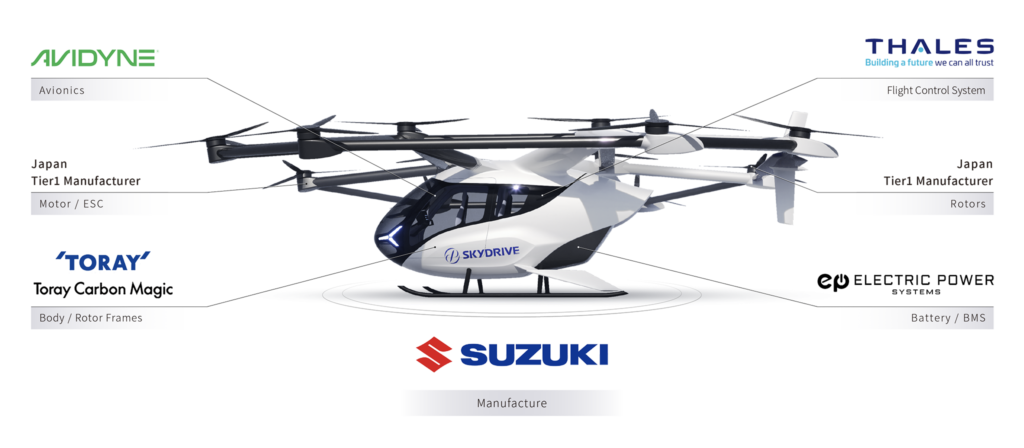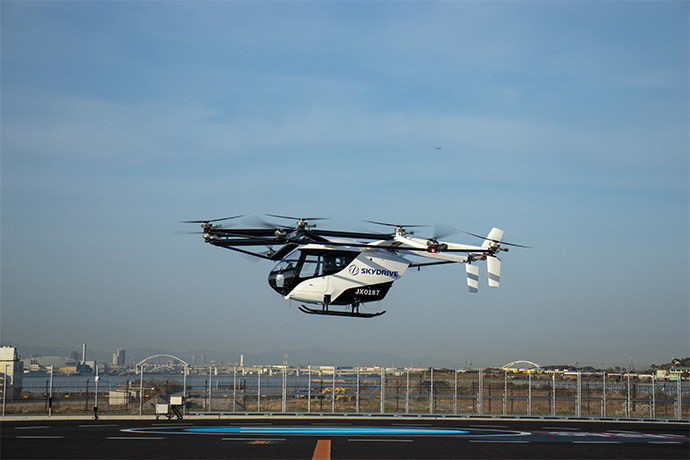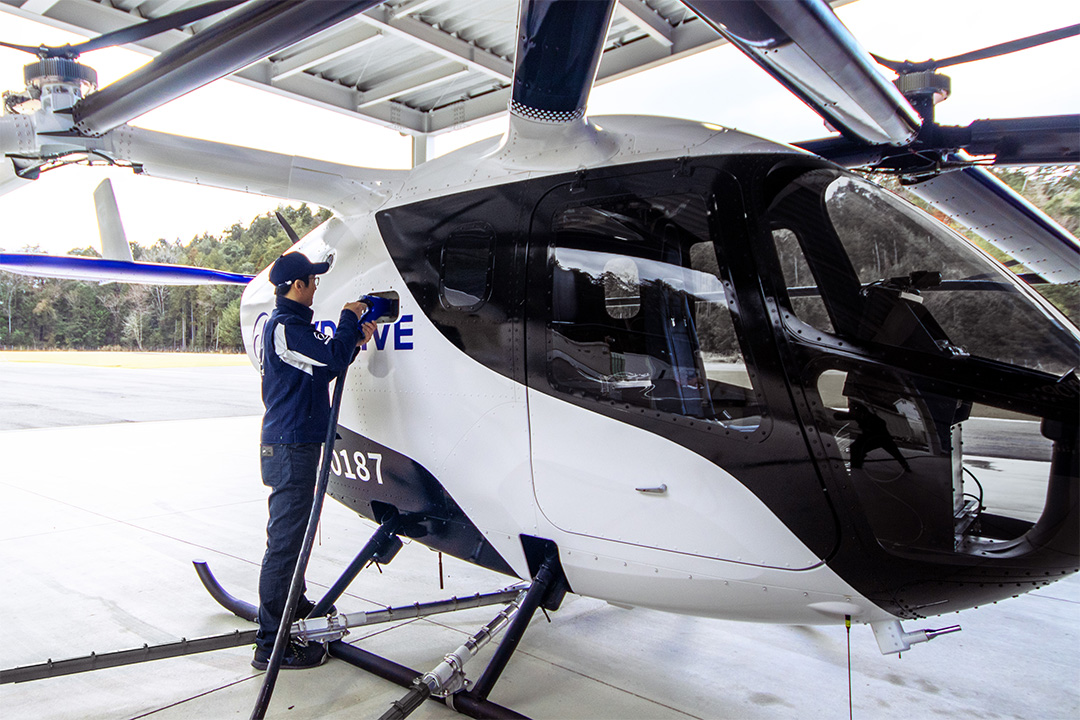There are more solutions than obstacles. Nicolas Zart
Congestion-busting is often the big persuader put out by eVTOL companies seeking to convince the fence sitters, as Yves Le Marquand, editor of Revolution.Aero just wrote. And from the very beginning, I sensed SkyDrive was onto something special by not focusing on the four-to-five-seater, but by testing its one-seater SD-03 and now with its three-seater SD-05. Why a three-seater and not four or five? The differences are exponential in terms of engineering, design, and testing time. Three seats allow you to start small, quickly, and on small routes, a strategy not many advanced air mobility (AAM) eVTOL companies have adopted.
Having worked closely with the company on communications and for CES 2022 for years, I watched up close as their vision for urban air mobility (UAM) took shape, pragmatically and not as a standalone novelty, but as an integrated, practical solution for modern cities within (AAM).
A Different Kind of eVTOL Vision
While much of the eVTOL world has focused on the promise of congestion-busting in gridlocked cities, four-to-five-seater eVTOLs, SkyDrive’s approach is refreshingly realistic. Their three-seat, wingless SD-05 isn’t built for long-range commutes. It’s purpose-designed for short, 10–15 minute hops, precisely the kind of journeys that can bridge the gaps between existing transport modes in densely populated places like Japan.

SkyDrive understood the local context from the get-go. In Japan, where public transport is already among the world’s most efficient, the idea of replacing trains or subways with air taxis simply doesn’t make sense. Instead, SkyDrive’s leadership saw a unique opportunity: use eVTOLs to extend the reach of rail networks, connecting major stations to outlying destinations and offering seamless, multimodal journeys. In other words, SkyDrive is actively delivering on the fundamental integrative approach AAM promises, multi-mobility. AAM is a sub-part of aviation, itself part of mobility. Demand-driven future mobility is about connecting rail, road, public transportation, sea routes, and, of course, air routes.
Rail Partnerships: A Strategic Masterstroke
The company’s recent ¥8.3 billion ($57 million) pre-Series D funding round, led by East Japan Railway Company and Kyushu Railway Company (with long-time financial backer and production site company Suzuki also participating), is the clearest sign yet that this strategy is resonating with the right partners. These aren’t just investors—they’re the backbone of Japan’s mobility infrastructure, and their buy-in signals a deep alignment of vision.
By working with rail operators, SkyDrive is doing more than adding a new layer to urban mobility. It’s integrating UAM into the already complex mobility mesh. They are maximizing efficiency, leveraging the strengths of rail for high-volume, cost-effective transport, and using eVTOLs to solve the “last mile” challenge that even the best train networks can’t always address. This strategy recognizes the value of every mode, rather than the tired and worn-out model of pitting them against each other.

I’ve seen this approach in action: SkyDrive’s work with Osaka Metro on vertiport feasibility, their plans to connect Morioka station to a nearby resort with JR East, and their ongoing collaboration with Kyushu Railway for future routes. Each project is a case study in thoughtful, data-driven integration, not just technological ambition. And they are not the only ones. A new wave of AAM 2.0 companies is refocusing on the essential, moving humans more efficiently, targeting where demand is not being simply driven by technology. Moore to follow up on that topic.
Beyond the Hype: Pragmatism, Realism, and Relevance
What I appreciate most is SkyDrive’s refusal to overpromise. In Japan and many parts of Europe, public transport is already so good that it will be difficult to shoehorn UAM. But it can be improved. The focus on short, high-value hops means chasing real-world demands and their adoption.
It’s also telling that, while $57 million is a substantial investment, it’s a fraction of what it costs to build a single kilometer of high-speed rail. This underscores the potential for eVTOLs to add flexibility and connectivity at a much lower marginal cost, making the whole system more adaptive to changing travel patterns.
A Model for UAM Everywhere
SkyDrive never seems to disrupt for disruption’s sake, but to build trust, forge alliances, and make sure every step forward is grounded in operational reality and integration.
What SkyDrive is doing in Japan could become a model for UAM globally:
- Partner with existing networks instead of competing with them.
- Design aircraft for the actual journeys people need to make.
- Focus on integration, not just innovation.

The Power of Seeing What’s Possible
Looking back, my early sense that SkyDrive was onto something wasn’t just about the technology; it was about their mindset. By recognizing the strengths of Japan’s rail system and working to enhance it, they are showing how UAM can be relevant, efficient, and truly transformative. Hey, that’s what a futurist does, after all.
SkyDrive’s story is a reminder that the future of mobility isn’t about replacing what works; it’s about building on it, intelligently and collaboratively. That’s the kind of innovation that lasts.
Check out our The Ways We Move podcast past episodes and stay tuned for more!
▶️ Watch on YouTube: https://www.youtube.com/@TheWaysWeMove 📺
🔊 Apple Podcasts: https://podcasts.apple.com/ca/podcast/the-ways-we-move/id1797599255 🔊
🎙️ Amazon Podcasts: https://music.amazon.com/podcasts/cd3349e1-275f-4691-ae38-f1b6a153d5e5/the-ways-we-move 🎙️
🎧 Listen on Spotify: https://open.spotify.com/show/4V0qe3eZqublwn6dasXWCf 🎧
📻 iHeart Radio: https://www.iheart.com/podcast/269-the-ways-we-move-268614085/ 📻
🌱 Buzzsprout: https://thewayswemove.buzzsprout.com/ 🗣️
📢 Subscribe for more insights into the future of mobility and support the show! https://www.buzzsprout.com/2428454/supporters/new 📡

